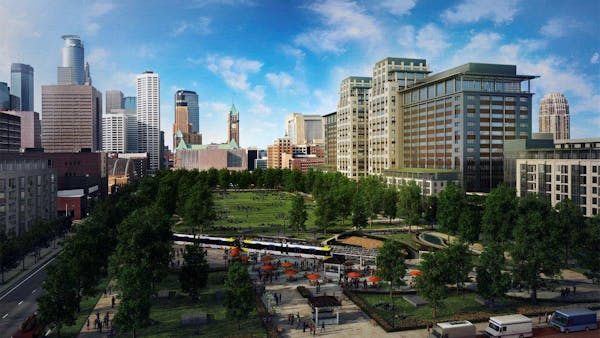It's the bold, glassy, ship-like look of the Minnesota Vikings' new home that has everybody talking.
But the surroundings are the thing that could very well turn the $975 million downtown Minneapolis stadium into one of the most remarkable urban parks in the land.
A schematic design submitted to the city of Minneapolis late last week by stadium architects calls for developing nearly 8 acres of park space immediately around the building that features grass, trees and wide walkways that will make it easy for walkers, runners and bikers to navigate around more than 1.6 million square feet of glass, metal and steel.
The intention, designers say, is to soften the impact of a massive building — nearly twice the size of the Metrodome — on the downtown skyline and make the area surrounding it more inviting to fans, neighbors and visitors, not only on game days but throughout the year.
"The whole approach that we've taken is that it's another one of the great civic spaces in the city on the east side of Minneapolis," said Tom Oslund, a local landscape architect working on the project with HKS Inc., the stadium's lead architect. "I think it's going to be a really cool urban park."
Plans call for a 2.7-acre plaza on the stadium's west — or downtown — end that will lead up to the five, 95-foot high pivoting glass doors that serve as the venue's main entrance.
Nearly 300 trees — likely a mix of elms, maples, lindens and other varieties native to Minnesota — will frame the plaza and building facade. Two walkways or paths — an outside loop near bordering streets and an inside loop that wraps tightly around the stadium — will circle the site, along with shard-like-shaped sections of park distinguished by a mix of perennials and native, ornamental and turf grasses.
Oslund said the designers' intent was to create "an open space area for people to gather," much like they can at the plaza at Target Field or at Gold Medal Park near the Guthrie Theater.
"Regardless of what side you first come in contact with, you are going to feel a sense of a green buffer," said John Hutchings, a principal with HKS.
The grade around the stadium varies, but no walkway slope is so steep to require handrails, making access relatively easy for fans or visitors with disabilities.
The steepest incline is on the building's east side — facing the Cedar-Riverside neighborhood. But even then, fans or visitors can navigate the slope by stairs or by walking a sidewalk that zigs and zags.
Plans also call for creating a 190-space surface parking lot buffered by trees on the southeast corner of the site. The lot would be used by players, coaches and stadium staff. Several hundred bike racks also would be installed.
Hutchings said the architects created "20 to 25 variations on themes" for the landscape design before deciding on what would be submitted to the city for review and approval.
"I think it's simple, I think it's elegant," said Michele Kelm-Helgen, chairwoman of the Minnesota Sports Facilities Authority, the public body overseeing stadium development. "I think it's going to give a whole different feel to the stadium and really connect it to the neighborhoods."
Kelm-Helgen said the landscape design work is included in the project's overall construction budget.
"I'm pleased with it," said David Fields, community development coordinator for the nearby Elliot Park neighborhood. "I think they did a great job of filling that space in a very unique and inviting way. It finally creates a connection. It's no longer a barrier."
While the stadium is certain to stand out on the horizon — at its peak, it will be more than 100 feet taller than the Metrodome — Hutchings said the playing field will be about 50 feet below the main concourse, softening the impact on the skyline.
"You take 50 feet right off the top, and it certainly helps," he said. "These are big, monumental buildings, and it's always a challenge to translate these large facades to a more human scale. Hopefully, that has been achieved."
Preliminary design plans also call for two skyways that would link the stadium to nearby parking ramps. Details won't be firmed up, however, until after the stadium authority and Vikings select a developer to build the ramps and skyways.
Kelm-Helgen said the authority and team are in the process of interviewing three bidders and plan to award a contract by mid-June.
Richard Meryhew • 612-673-4425
Hopkins parents charged in 9-year-old daughter's deadly asthma attack

Trail section at one of Minnesota's most iconic spots closing for rehab

After a bumper crop of new sales taxes approved in 2023, legislators eye limits
Want to celebrate 4/20? Here are 32 weed-themed events across Minnesota.

